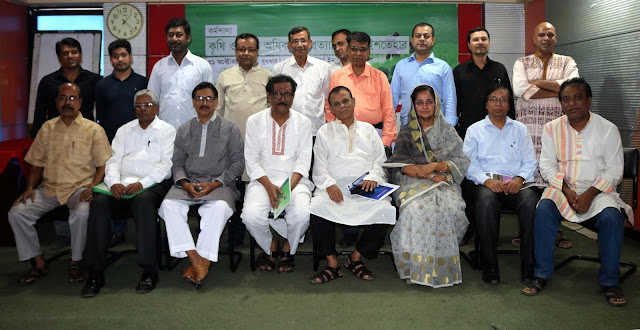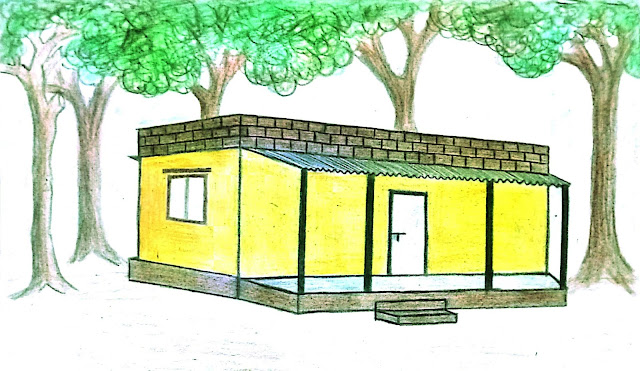Oil Spillage Disaster in the Sundarbans and Other Questions
Khulna, 11 December 2014
One of the World's natural Heritage Site and
Ramsar site is going through a severe disastrous situation after huge oil
spillage in river Shela. Sundarbans, the largest single tract mangrove forest
of the world is in threat now. A local oil-tanker 'OT Southern Star-7' sank with 367 metric ton furnace oil after a hit by another cargo vessel 'MT Total' in
Shela River of the Sundarbans, which is 6 kilometers far from Mongla sea port.
It is the second oil spillage in last twenty years. A foreign vessel named MV
Pavlina sank near Mongla port with 193 metric ton of heavy oil.
The place where it is happened is a wildlife
sanctuary for aquatic fauna including rare Irrawaddy and Ganges dolphin, and
also Bengal tiger, deer, wild boar etc. The concerned institutions which
include Bangladesh Navy, Mongla Port Authority (MPA), Forest Department (FD),
Bangladesh Inland Water Transport Authority (BIWTA) or Bangladesh Shipping
Corporation (BSC), Department of Environment (DOE) and Bangladesh Petroleum
Corporation (BPC) failed to take an effective and immediate decision to reduce
vulnerability of world largest single tract mangrove Forest.
So, people including the environmentalists are
asking three questions repeatedly: Is Sundarbans capable of recovering the
damage alone? Who is or are responsible for this devastating accident? And how the
oil spill can be removed? The questions are short and easy, but the answers
maybe long, because the accident is a consequence of ignorance, bad governance
and worthless activities.
It is clear that the oil tanker and its owners are
primarily responsible for the catastrophic incident. The tanker was a sand
carrying cargo, and they converted it to an oil tanker without any security
measure. So, it is clear that they considered nothing but profit to run a
marine cargo service. But are they alone at this side? There are several
questions can be raised.
How and under which process a sand-cargo
changed to an oil tanker? Petro Bangla, a state-owned company for oil and gas
exploration, has allowed carrying petroleum in the vessel, instead of BSC which
is the legal authority for inspecting and giving licence to the large vessels. Does
Petro Bangla have eligibility or enough skill to inspect vessels? No answer. For
the discussion, let's accept the license. Then we may have more questions? The
vessel loaded furnace oil from Padma Oil Company situated in Khulna. Why didn't
the oil company check the vessel before loading huge amount of oil in it? No
answer.
Okay, let's carry forward. Why was the
oil-tanker navigating through Shela River which is a wildlife sanctuary? Because,
the regular route, Ghashiakhali Channel, was dried up due to heavy salinity and
BIWTA advised all commercial vessels to use Shela River as an alternative, and
it failed to dredge Ghashiakhali Channel in last 3 years, although it spent
around 300 million Bangladeshi Taka for dredging. The department didn't change
its advise even after an order from Prime Minister of Bangladesh (24 November
2011) and several concern letters from Ministry of Environment and Forest. Why did
the Ministry ignore Prime Minister's order? No answer.
Puzzled? It is not the end of questions. Commercial
vessels are not allowed to navigate through Shela River at night and have to
anchor at FD Jetty. But the vessel was anchored at middle of the river without
any prior notification. But FD didn't take any immediate action - seize, financial
penalty or court case - against the vessel. Then how do they avoid their
liability? No answer.
Question can be raised on institutional
preparation also. Three international institutions had conducted a research in
2002 on behalf of FD. The report warned Bangladesh Government about
possibilities and serious consequences of oil spillage in the Sundarbans. The
report recommended to (a) train concerned employees to response quickly on oil
spill (b) Formulation of National Marine Pollution Contingency Plan and
National Oil Spillage Response Plan (c) Coordination between FD, Coast Guard, MPA,
BSC and DOE (d) Regular monitoring, collecting machineries and (e) Readiness of
communities with locally available booming and clean-up materials. Bangladesh
also signed SAARC Oil Spillage Response Plan in 2003. More than a decade has
been passed but the preparation is at the lowest level even now.
These questions are valid. But prior to this,
immediate question is how the Sundarbans can be survived? The immediate steps
should be creating a booming by using cheaper and locally available materials
like bamboo, straw bale, logs etc. At least we could reduce damage by salvaging
half-submerged vessel. But the authorities took 3 days to take an appropriate
decision although office MPA, Coast Guard, Bangladesh Navy and FD is within 4
kms of the spot. They tried to use dispersants which was a destructive decision;
and it postponed the decision after huge protest from different green groups
including Sundarbans Watch Group (SWG) and Coastal Livelihood and Environmental
Action Network (CLEAN).
After three days, government allowed local
people to clean-up oil from rivers without any training or cautionary measures
and BPC started purchasing the collected oil on a reduced rate. Only 48.2 ton
of oil could be collected till date. Meanwhile the oil has been spread-out in
70 kms up and downstream of the Sundarbans region. According to the newspapers,
at least 360 sq. kms of the Sundarbans is seriously affected by the oil spill
and death of fishes, birds, crabs, lizards and Irrawaddy Dolphin has been
reported.
So, it is too late to response from early level
of the disaster and we need a comprehensive huge activity to save Sundarbans
from permanent damage. If we take lessons from other countries, it is clear
that the appointed government officials or local people are not enough to
clean-up floating oil from such a big area. So, it is a time to gather
thousands of volunteers from all over the country in a disciplined manner under
civil administration and Bangladesh Navy. To this end, we demand a state of
environmental emergency in the Sundarbans. We believe that, if the government
call youth groups including students, environmental activists and human rights
groups -thousands of youth come out with their best efforts.
Local soaking materials like banana tree, sacks,
jute, rags and straw bale have no alternative to suck floating oil from rivers
and canals. Oil eating bacteria and sorbents are used by developed countries.
But Bangladesh, one of the least developed countries, may not be able to
collect these materials without external support.
We should be cautious that prop roots and
Pneumatophores are oil coated now. Young environmental activists may intentions
to clean-up those. That will be a well intentioned but misguided response.
Walking around in the mangrove forest forces the oil deeper into the soil and
makes the damage worse, not better, even if some oil is removed. All oil
recovery should take place at the edge of the mangroves, in tidal canals and
open waters.
One further concern is the health safety of oil
cleanup workers. Many workers are possibly to get sick from exposure to the
oil, some by breathing the fumes and others by skin contact with the oil. As
the workers don't have gear, masks and gloves a serious issue of health hazard
likely to be raised.
We hope, the Sundarbans is able to heal itself
and regenerate the flora and fauna with its high capability of adaptation with
adverse situation. But we are not sure about losing one or more species of
microorganisms, planktons, invertebrates, molluscs, fishes, birds, amphibians,
lizards or mammals from the Sundarbans. That will impact on ecosystem of the
mangrove forest and, of course, on the people living in the adjacent areas.
Maybe, we will cry for any of those species after a century when scientists
will innovate potentiality of such a species.
Will
we be able to save the Sundarbans from this disaster?
* Hasan Mehedi, Member
Secretary of Sundarbans Watch Group and Chief Facilitator of Coastal Livelihood
and Environmental Action Network (CLEAN)

